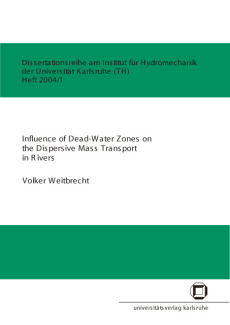Volker Weitbrecht
Influence of dead-water zones on the dispersive mass transport in rivers
Reihe: Dissertationsreihe am Institut für Hydromechanik der Universität Karlsruhe (TH)The dispersive mass transport in rivers has been investigated to improve the predictability of transport scenarios in case of accidental pollutant spills. In particular, the influence of dead-water zones, as they are given by groin fields, on the transport characteristics in the main stream has been analyzed. A literature review of detailed map material from the rivers Rhine, Waal and Elbe has been performed, in order to plan representative laboratory experiments. Typical aspect ratios of the groin fields as well as typical inclination angles have been summarized. Based on these results, experiments have been performed in a laboratory flume equipped with schematized groins. Within theses experiments the aspect ratio, the inclination angles as well as the groin field volume has been varied. Due to the fact that the flow is very shallow and, therefore, quasi two-dimensional, the flow velocities have been determined at the water surface, using a Surface Particle-Image-Velocimetry-System that has been developed for that purpose. Additional measurements, using a two-dimensional Laser-Doppler-Velocimeter, have been performed for resolving the velocity distribution over the water depth. With the help of these measurements it was possible to determine the typical recirculating flows in the groin fields as well as the coherent, horizontal eddies in the mixing layer between dead-water zone and main stream, that are governing the mass exchange. The high spatial and temporal resolution of the surface PIV measurements made it possible to estimate also the mass exchange between groin field and main stream. With the help of Planar-Concentration-Analysis, which is a method for determining depth-averaged planar concentration fields, it could be shown that the mass exchange between groin field and main stream increases with increasing length of the groin field. For these measurements a tracer injection device has been developed, that consists of a movable multi-port injection-box and vacuum-pressure-unit, which is able to produce instantaneously, homogeneous and reproducible concentration fields. Finally a Lagrangian-Particle-Tracking-Method was developed to transfer the results, obtained locally at single groin fields, into the overall transport characteristics in the far-field of pollutant spill scenario for a river system consisting of a series of groin fields. Through the implementation of a transient-adhesion-boundary, it was possible to parameterize the influence of groin fields on the longitudinal dispersion, the transport velocity and the skewness of the concentration distribution in the case of a pollutant spill.

